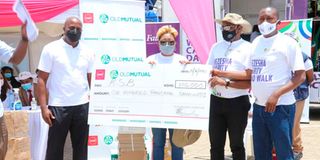Union unveils smart white canes for the blind, to cost Sh10,000

What you need to know:
- Unlike the regular white cane, the smart cane is fitted with an electronic device that detects obstacles that are three meters away while communicating to the user via vibration.
- The cost of one smart white cane is Sh10, 000 which is not affordable to most blind people in Kenya.
The Kenya Union of the Blind (KUB) has launched a nationwide campaign that aims at distributing smart white canes popularly known as smart canes.
The canes use smart technology to help visually-impaired people navigate their surroundings.
According to the union, the campaign is a partnership between KUB and the national association of the blind and Vallab Youth Organisation (VYO), a charitable organisation.
KUB Executive Director Jackson Agufana told Healthy Nation that the partnership with VYO hopes to ensure that as many blind people as possible have access to the smart canes.
“A regular white cane or a smart cane is therefore considered the first step to independent living in visually impaired community.
“We are working with VYO to mobilise funding for the smart canes so as to ensure that as many as possible blind people in Kenya have access to the smart canes.The cost of one smart white cane is Sh10, 000, which is not affordable to most blind people in Kenya,” said Mr Agufana.
KUB, which further indicated that their roll-out is targeting 100,000 blind people, explained that unlike the regular white cane, the smart cane is fitted with an electronic device that detects obstacles that are three metres away while communicating to the user via vibration.
“The electronic device that is trading under the Saarth brand name uses ultrasonic sound to detect the obstacles. It has a sensor that can transmit and receive ultrasonic sound waves.
Once the device detects the presence of an obstacle in a particular direction and distance, a warning is issued to the user in the form of vibrations similar to the vibration of a cell phone.
With the smart cane, blind people can now avoid obstacles that cannot be detected by a regular white cane such tree branches, hanging cloth lines, open windows and protruding air conditioners which pose the risk of injury for the head and upper body of a blind person.
To use the white cane, the user has to charge the electronic device battery using the android phone charge.
When fully charged, the battery can last for 50 hours,” the body highlighted.
“Currently, we are importing the smart white canes from India with the support of well-wishers because most of our members cannot afford them,” Mr Agufana added while pointing out that there is need for Kenyan innovations to promote the inclusion of the visually impaired persons in the society.
VYO Secretary Komal Chotai said 200 smart canes have already been distributed in Nairobi, Kisumu and Nakuru.
“We have distributed 100 in Kisumu, 40 in Nakuru and 50 in Nairobi.”
The launch was received with excitement.
Angela Nzilani, a blind woman who used to depend on the support of a guide, was among the first 50 recipients of a smart cane that can detect obstacles three metres away thus aiding her to move about independently.
“With the regular white cane, movement was not easy for me because there were obstacles that may not be identified. To avoid hitting obstacles, I have been depending on the help of my family and friends to guide me in movement. However, with the smart cane, I can now move independently and engage in my work with ease,” Nzilani said.
An elated Moses Kilonzo, who is totally blind, said that the smart cane will come in handy at the voting booth in 2022 as he gears up to vote in the coming general election.
“With this smart cane, I will be able to navigate the polling stations, go to the booth, and cast my vote. If the IEBC will produce tactile ballot and I have this smart cane, then for the first time I will participate in the election through secret ballot,” he said.
There are 333,520 persons with visual impairment according to the country’s 2019 census report, with most residing in rural areas and in informal settlements with little to no access to education, employment and assistive devices.
The bulk of the visually impaired Kenyans depend on their families for upkeep and mobility.





